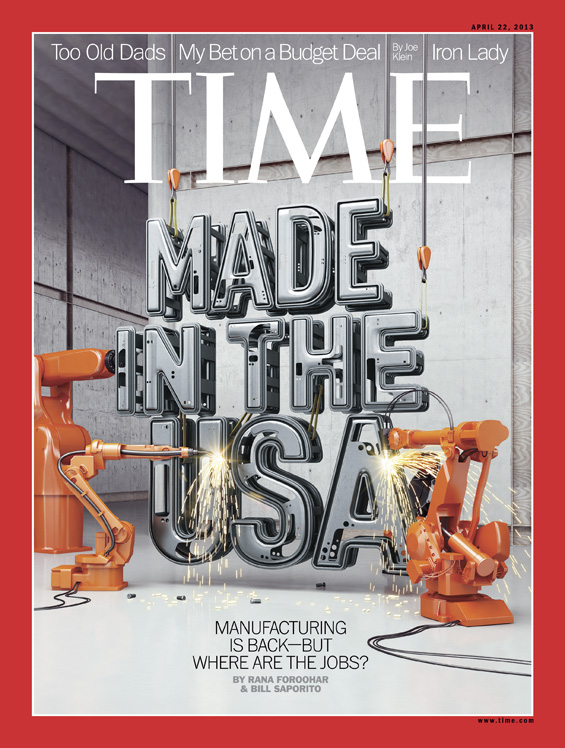 Fascinating cover story in Time magazine about the renaissance in US Manufacturing.
Fascinating cover story in Time magazine about the renaissance in US Manufacturing.
What is so interesting about this is while new businesses are being created, the amount and kinds of jobs that go with this are very different than what the manufacturing sector produced in the past.
Some takeaways from the article:
• Post-recession, U.S. manufacturing growth is outpacing other advanced nations;
• 500,000 manufacturing jobs created in the USA over the past three years;
• U.S. factories access to cheap energy, (oil and gas from the shale boom) means cheaper costs versus expensive overseas Oil and costly shipping prices.
• Energy- and resource-intensive industries (chemicals, wood products, heavy machinery and appliances) do better, powered by that cheaper homegrown energy.
• New made-in-America economics is centered largely on cutting-edge technologies (3D printing, specialized metals, robotics and bioengineering);
• New US factories are “superautomated” and heavily roboticized;
• Employees typically are required to have computer skills and specialized training; Minimum of two-year tech degree, which is likely to rise to four-year degree (eventually);
More machines and fewer workers is the future of manufacturing in the USA. But looking only at factories misses some of the new jobs that are related to these industries. Many of the jobs created are outside the factory floors — R&D, support services, software engineers, data scientists, user-experience designers, transportation & shipping, etc.
Perhaps this helps to explain why every $1 of manufacturing activity returns $1.48 to the economy.
Here is an excerpt:
“Today’s U.S. factories aren’t the noisy places where your grandfather knocked in four bolts a minute for eight hours a day. Dungarees and lunch pails are out; computer skills and specialized training are in, since the new made-in-America economics is centered largely on cutting-edge technologies. The trick for U.S. companies is to develop new manufacturing techniques ahead of global competitors and then use them to produce goods more efficiently on superautomated factory floors. These factories of the future have more machines and fewer workers—and those workers must be able to master the machines. Many new manufacturing jobs require at least a two-year tech degree to complement artisan skills such as welding and milling. The bar will only get higher. Some experts believe it won’t be too long before employers expect a four-year degree—a job qualification that will eventually be required in many other places around the world too.
Understanding this new look is critical if the U.S. wants to nurture manufacturing and grow jobs. There are implications for educators (who must ensure that future workers have the right skills) as well as policymakers (who may have to set new educational standards). “Manufacturing is coming back, but it’s evolving into a very different type of animal than the one most people recognize today,” says James Manyika, a director at McKinsey Global Institute who specializes in global high tech. “We’re going to see new jobs, but nowhere near the number some people expect, especially in the short term.”
If the U.S. can get this right, though, the payoff will be tremendous. Labor statistics actually shortchange the importance of manufacturing because they mainly count jobs inside factories, and related positions in, say, Ford’s marketing department or at small businesses doing industrial design or creating software for big exporters don’t get tallied. Yet those jobs wouldn’t exist but for the big factories. The official figure for U.S. manufacturing employment, 9%, belies the importance of the sector for the overall economy. Manufacturing represents a whopping 67% of private-sector R&D spending as well as 30% of the country’s productivity growth. Every $1 of manufacturing activity returns $1.48 to the economy. “The ability to make things is fundamental to the ability to innovate things over the long term,” says Willy Shih, a Harvard Business School professor and co-author of Producing Prosperity: Why America Needs a Manufacturing Renaissance. “When you give up making products, you lose a lot of the added value.” In other words, what you make makes you.”
The full article is well worth your time to read . . .
Source:
Made in the USA
Rana Foroohar and Bill Saporito
Time, April 2013
http://business.time.com/2013/04/11/how-made-in-the-usa-is-making-a-comeback/


What's been said:
Discussions found on the web: